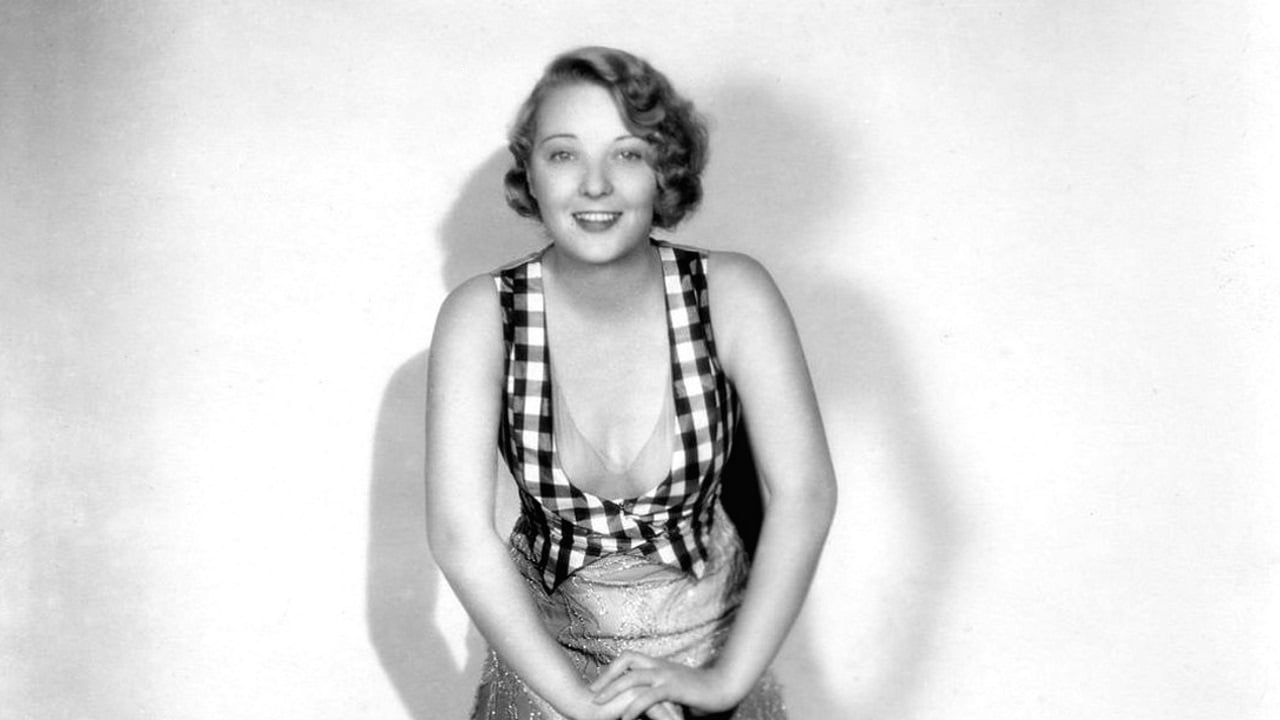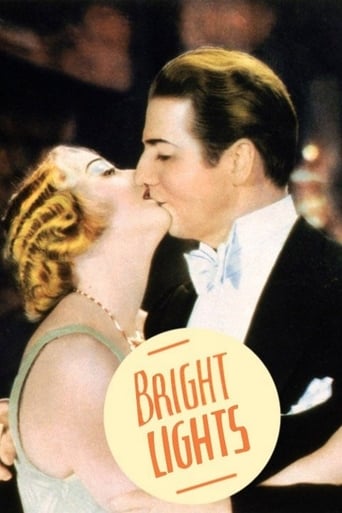

"Bright Lights" (re-named "Adventures in Africa" for TV broadcasting many years after its release) is a cinematic Mulligan stew consisting of a murder mystery, multiple love stories, several musical numbers, and tedious stretches of low comedy barely held together by a witless and improbable script about a show girl (Dorothy Mackaill) who, with her partner- manager (Frank Fay) shimmies her way from small-time tropical dives and traveling carnivals to the Broadway big-time only to announce that she's giving up the stage to marry into wealth (in the person of Philip Strange as Mr. Emerson Fairchild of Long Island whose accent is British but whose mother's is Midlantic). The Fay character loves and protects Mackaill in a fatherly or businesslike manner but refrains from marrying her; every time he is about to give in to that urge he pulls back because some part of him senses that he is not worthy to be her husband. Mackaill finds his hot/cold behavior frustrating and infuriating. The development of this complex relationship takes a back seat to sometimes heavy-handed subplots enacted by the likes of Eddie Nugent in an ill-defined role (star's press agent?) eagerly trying to manage a gaggle of reporters which includes a barely visible young John Carradine and an all-too-visible Frank McHugh as an obnoxious drunk, who have assembled to cover Mackaill's final performance; James Murray and Inez Courtney as young lovers; Tom Dugan and Daphne Pollard as a violently discordant married dance team; Noah Beery as a lecherous figure from Mackaill's and Fay's sordid African past. Other, later, pre-Code films with similar elements include "I'm No Angel," "Forty-Second Street," "Murder at the Vanities" and Mackaill's outstanding 1932 feature "Safe in Hell."As far as the songs go, "Wall Street" near the beginning, despite a stage-filling chorus and carloads of set pieces and costumes, falls flat, even with expert song-and-dance man Fay at the center. He comes off better in the Harry Akst-Grant Clarke standard "Nobody Cares If I'm Blue." In dramatic scenes, however, his haggard appearance distracts from his emotionally nuanced performance. The makeup applied to his rugged features suggests Count Dracula and clashes with his gently rapid speaking voice and smooth singing style and stage manner. Among the other musical numbers, "Song of the Congo," "I'm Crazy for Cannibal Love" and "I'm Just a Man About Town" are the catchiest, both visually and melodically, though one can't help wondering what Busby Berkeley might have done with the staging. Mackaill is the centerpiece of all three; she performs a hula-type dance in the first two and wears a man's tux and top hat in the first half of the latter before emerging via camera trickery from the huddle of a male chorus wearing a dress. She also has some effective dramatic moments but, due perhaps to sloppy editing, misfires during a poorly staged dressing room temper tantrum. Her vocal range is limited, but she carries her songs confidently, dances gamely and looks magnificent in skimpy, spangled costumes as well as in screen-filling closeups.
... View MoreA catastrophe! I like a lot of early sound films but this is to awful to describe. An incoherent mess that Warner's pulled before release and retitled "Adventures In Africa." This was an improvement on the original title. Having read a Barbara Stanwyck biography, I wanted to see Frank Fay's performance. You can see why his movie career failed. Some reviewers point to this movie as a transitional sound film and it might be better in it's original lost Technicolor print. Color would only point out the garish sets and costumes and Gong Show performances. Don't waste part of your life on this. If you want to see an entertaining musical from this period wait for TCM to show "Sally" or "Spring Is Here".
... View MoreThe First National Musicals that have been turning up on TCM are interestingly elephantine antiques for fans of old movies. In many ways they are as interesting for what the film makers got wrong as what they got right. No Broadway theater ever had such immense stages as are seen in this one, not even the new ones, miked when they were built. The chorus lines are dwarfed on the stage.Likewise, director Michael Curtiz and cinematographers Lee Garmes and Charles Edgar Schoenbaum can't seem to figure out how to stage people for camera and microphone. Frank Fay seems stagy and ill at ease in close-ups and two-shots, but when he is performing on stage and shot in medium long range from about the sixth row, (although there are no seats) he is fine. Contrariwise, star Dorothy MacKaill is at her best in Dutch angle close-ups. She may have started as a chorine, but she had become a star in silent pictures.The other performers offer interesting contrasts. Who know that Daphne Pollard could sing? Can you spot John Carradine in his first film performance? Could Frank McHugh be more annoying as a drunk reporter? These are the things that make this movie interesting more than eighty years later.They don't make it good. The movie musical went into eclipse for three years from ill-managed things like this. It's certainly not hard to understand why.
... View More... in one of the wacky early talkies that I bet Michael Curtiz wishes he could have erased from his resume.I give this 7 stars mainly for the early talkie fan. It really is pretty good for a 1930 back-stager and pretty original. The alternate title "Adventures in Africa" is rather puzzling since the movie spends all of ten minutes there, in a South African cabaret. However these are important moments as the conclusion to the entire story is dependent on events there.The movie opens with Louanne's (Dorothy Mackaill) last night on the Broadway stage as she is marrying the wealthy Fairchild after the show. Fairchild is accompanied by his sour-faced mother and sister who look more like they are going to a funeral than a wedding since they are none too happy about the family heir marrying an entertainer. Frank Fay has a very good role here as Wally, the man who has been Louanne's protector and somewhat on-stage partner for years. Wally is definitely in love with Louanne, and Louanne seems to have a bit of a thing for Wally in spite of her engagement, although the love has remained unrequited. If you think it the thing of curiosity seekers to see Frank Fay playing romantic lead to Dorothy Mackail, then think again. The two have real chemistry.The fly in the ointment? Noah Beery as the diamond smuggler Miguel who resents Louanne because she once forcefully resisted his attempted rape. Honestly, Mr. Beery! Didn't Warner Brothers ever think you plausible as simply asking a girl out for dinner and a show? In every early Warner Brothers talkie in which I've seen Mr. Beery he's either threatening human sacrifice (Golden Dawn) or execution by firing squad (Noah's Ark) in order to have his way with a woman.Besides all of the drama, there are some really great musical numbers, some bizarre to the point of being charming. The opening number has Frank Fay in a big musical production entitled "Wall Street". From the lyrics people didn't like bankers any more in 1930 than they do today. After seeing Dorothy Mackail scantily clad for the tropical hula number "Cannibal Love" in which her fellow cannibals yield shields with crosses on them - maybe they ate some Crusaders??? - she returns for "Man About Town" dressed like Fred Astaire in tuxedo and tails with her blonde hair hidden under her top hat. The grand prize for most bizarre number has to go to a very short jazz number performed in the South African club by an unnamed stout short female singer with a booming voice accompanied by a rather clumsy chorus dancing right behind her. It looks as if any of the chorines took a wrong step and kicked just a little harder the jazz singing dynamo would have taken it right in the pants and landed in the front row of the audience.Also look out for Frank McHugh as a drunken fresh reporter who even in 1930 is sporting his trademark mischievous laugh and James Murray of "The Crowd" in a rare talkie appearance.I watched the Warner Archive copy of Bright Lights, and if you want to see it the way it should be seen I would advise getting a copy of this restored version. It doesn't have that fuzzy look that black and white copies of two strip Technicolor films generally have, and the picture and sound are crisp and clear throughout.
... View More